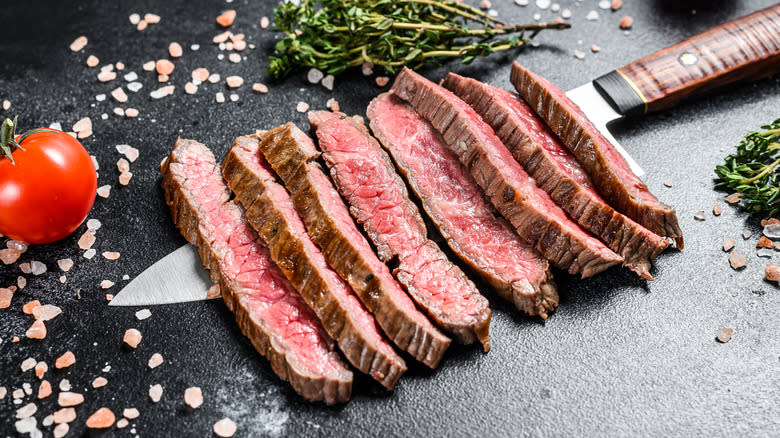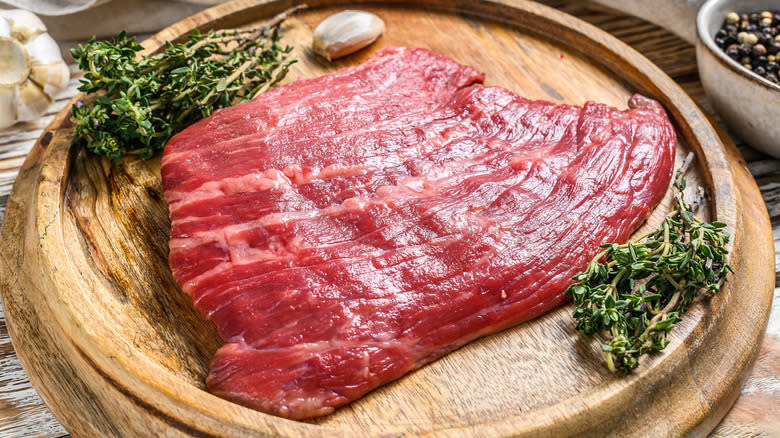Flat Iron Steak Was Invented Way More Recently Than You Think

We tend to think of cuts of steak as being old, established classics. After all, cows were domesticated over 10,000 years ago, so we've had plenty of time since to figure out how to get every possible cut of meat out of them. So it's no surprise many of the cuts of steak you need to know are pretty old: strip steak (whether you call it a New York strip or a Kansas City strip) dates to 1827 at Delmonico's Restaurant in New York City, while sirloin has been around long enough that there are urban legends about it being named in the early 1600s.
There's one steak cut, though, that's more recent -- way more recent -- to the point where it's barely older than the iPod. This is the flat iron steak, which isn't just one of the best cuts of steak for a dinner party, but also a triumph of meat science. It all started in 1998, when the National Cattleman's Beef Association tossed substantial grant money to a couple of scientists in the hopes of finding a new type of steak that had somehow been previously overlooked. Incredibly, those intrepid meat researchers succeeded beyond anyone's wildest dreams.
Read more: The 13 Best Steaks For Grilling
Heavy Testing Revealed One Previously Undiscovered Cut

It may seem odd that "meat scientist" is an actual career, but it's true -- at least for Chris Calkins of the University of Nebraska and Dwain Johnson of the University of Florida. In the late '90s, they put that title to good use when the NCBA gave them a $1.5 million grant to find an entirely new cut of steak. The pair tested 5,600 muscles to try to find something to fit the bill, and while they ultimately narrowed it down to 39 possibilities, there was one that stood head and shoulders above the rest.
Before these experiments, the chuck (aka the shoulder area of the cow) was considered good only for things like ground beef for hamburgers. But what Calkins and Johnson discovered in 2001 involved a particular part of the chuck called the top blade that had largely been overlooked for its high degree of connective tissue. When butchered properly, the top blade could actually be trimmed in a specific way to get rid of the sinew, resulting in an extremely flavorful and surprisingly affordable steak unlike anything on the market at the time. It required a significant amount of skill from butchers, but the end result was more than worth it.
Flat Iron Steak Is Surprisingly Versatile

Dubbing the result the flat iron steak for its resemblance to an old fashioned flat iron (broader at one end and tapered at the other), the NCBA went on a press blitz to popularize the new creation. The results were almost immediate, with flat iron rapidly becoming one of the top ten steak cuts in America both by volume and total sales over the next two decades. While their biggest hit, flat iron steak wasn't Calkins and Johnson's only success -- if you've ever wondered what a Denver steak is or how you should cook it, that was another discovery of theirs.
In addition to being a delicious cut known for both flavor and affordability, it's also very versatile, as one of the best cuts of beef to use in place of flank steak (despite coming from a completely different part of the cow). It does very well with marinades and makes a great cut for tacos, whether you treat it as a slow-cooked meat or grill it. Today, the flat iron is a staple on restaurant menus across the country, and we wouldn't have it without a beef industry trade group and a couple of meat scientists deciding to figure out whether they could reinvent the steak at the turn of the millennium.
Read the original article on Daily Meal

